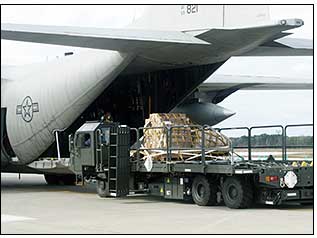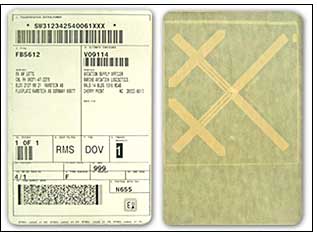The United States Army has been taking the lead in pushing the adoption of RFID technology, but the U.S. Air Force isn’t far behind with an initial implementation of passive RFID. On Nov. 8, the Air Force will begin a pilot that tracks shipments and pallets from four locations in the United States to two air bases in Germany.
The 30-day trial was described by Mark Reboulet, the Air Force’s automated identification technology manager, at the Truth in Technologies 2004: RFID & Bar Codes Forum, held in Stony Brook, N.Y., last week. The forum was organized by the AIDC 100, a not-for-profit organization of automatic identification and data capture professionals.
The Air Force already uses bar codes to track cases and pallets being put into shipping containers bound for overseas bases. Reboulet said that the Air Force wants to be able to quickly and accurately disaggregate shipments and know where individual pallets need to be shipped.
One goal of the test is to see how effective the RFID equipment is and whether it can reduce the amount of labor involved with collecting data and associating cases with pallets and pallets with containers.
“We want to demonstrate that we can track shipments hands-free, without changing our business processes,” said Reboulet. “We want the soldier in the field to process shipments as he or she always has. The name of the game is improving visibility.”
At Charleston Air Force Base in Charleston, S.C., Seymour Johnson Air Force Base in Goldsboro, N.C., Dover Air Force Base in Dover, Del., and one depot run by the Defense Logistics Agency (DLA), employees will print 4-inch by 6-inch military shipping labels (MSLs) with embedded Class 0 EPC RFID tags and attach the labels to shipments—a large item or cases with several items—moving through Dover Aerial Port to the Spangdahlem and Ramstein Air Force bases in Germany. Each MSL, which is a standardized label with a two-dimensional bar code, will contain information on the contents of a pallet as well as its destination.
The Air Force hasn’t finalized what types of products will be tracked. But it will put associate each label’s EPC number with a particular shipment, and that information will be stored in a database linked to the military’s In-Transit Visibility network. The cases will be scanned by fixed readers stationed at dock doors as they are shipped out of the Charleston, Seymour Johnson and DLA facilities and scanned again by readers when they arrive at Dover Air Force Base in Dover, Del. The cases will be tracked through the Aerial Port, an air cargo shipping facility within the Dover Air Force Base, where they will be loaded onto pallets.
After a pallet is completely built, the Air Force will print a bar-coded pallet label with an embedded EPC tag. All the cases will be associated with the tag embedded in the pallet label and the data will be uploaded to the ITV system.
The pallet EPC tag will be read as the goods leave Dover and again when the shipment arrives at the air bases in Germany. Each time a case or pallet tag is read, the data will be stored in the ITV system, so suppliers and the military personnel overseas that order the goods will be able to see their shipments move through the system.
“We will try to read as many box labels as we can on the pallet,” said Reboulet. “But we expect to read all pallet tags.”
The pallets will be broken down and the boxes will be stored in different bins, depending on where the boxes are being sent. A reader above the bin will read all the tags on boxes in the bins. That data will be uploaded to the ITV, so the Air Force will have visibility from the Charleston, Seymour Johnson and DLA facilities until boxes are delivered to local units in Germany.
A team of technicians has been installing readers from Northrop Grumman, a military contractor based in Williamsburg, Va., at dock doors within the Aerial Port at Dover Air Force Base for the past two weeks, and another team has been in Germany this week to install RFID readers from Symbol Technologies (formerly Matrics) at air bases on the pallet line as well as the entrance and cross-docking and delivery bins areas within bases’ theater distribution facilities. The readers being installed in Germany are based on FCC regulations and can be used on the Air Force base only through December 2004. After that, they must be adjusted to conform to European regulations.
The Air Force has purchased 5,000 labels with Class 0 EPC tags from Symbol for the test. Reboulet said the Air Force’s tests determined that Intermec tags based on the ISO 18000-6 air interface protocol provide the best read range, but when the DOD indicated it preferred EPC tags, the Air Force switched to the Class 0 tags, which got nearly 15 feet of read range.
The current tests will run using PCs connected to the RFID readers. The data will be sent from the PC to an ITV server for analysis. The data will not be sent to or be accessed by enterprise software applications. By the end of the year, the Air Force expects to have a detailed analysis of how complete, accurate and timely the RFID data-collection process was. Phase 2 of the test will involve read-write EPC Gen 2 tags and integrating data with logistics and warehouse management systems.



